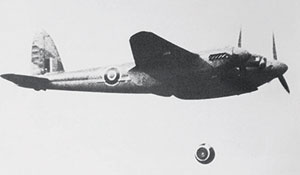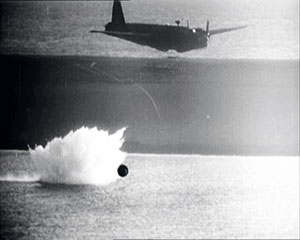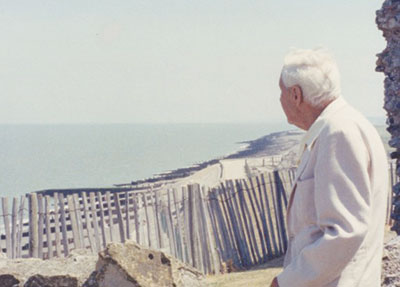
The Bouncing Bomb
This month we have been discovering more about the fascinating story behind the bomb that could skip across water.
It is perhaps a sad reflection on the British psyche that one of the popular TV adverts from the early 1990s featured a drinker of a well-known brand of lager ‘bouncing’ his towel across the swimming pool to land it on a prime location Spanish sunbed, all to the tune of the Dam Busters theme.
Some 20 years before the referendum vote on leaving Europe, there was an undeniable, underlying hint of xenophobia about our character, but at the same time the iconic wartime raid on the German Dams using the Barnes Wallis ‘bouncing bomb’ is something that we have every reason to be proud about.
80 years ago, this spring, a squadron of modified Lancaster bombers took off from Scampton airfield, flying south-east over enemy territory before swooping down to below what today would be masthead height, in the pitch dark, to bounce their bombs across the surface of the water and into the massive dams. Little wonder then that this is an action that today, even after so many years, is one that still stirs the senses as the bravery, not to mention the sacrifice of so many lives, plus the clever innovation behind the weapon, all speaks of ‘Britain at its best’.
What may, though, be a surprise to our readers is just how much of the original development of the idea (which Barnes Wallis successfully obtained a patent for in August 1942) took place around some of our most popular stretches of coastline.
GETTING THE FACTS RIGHT

A Mosquito of 618 Squadron, the sister unit to the dam busting 617 Squadron, test drops a ‘highball’ – the anti-ship version of the bouncing bomb
Image: MoD
Some of these gaps in our knowledge stem from the 1955 film The Dam Busters, for as a source of information this was badly flawed. At the time the film was made, the technology behind the bouncing bomb was still firmly on the Secret List, which forced the producers into a number of factual fudges. One of the biggest of these forms the early part of the film, where the avuncular Barnes Wallis faces down the powers of authority to get his idea accepted, and while this made for an exciting and engaging film, it simply is not borne out by the facts.
For a starter, the idea of attacking a number of German dams predated the outbreak of hostilities, as they were already on a list of high value targets worthy of attack, as and when we had the capability to do so. Nor was the idea unique to the UK, as the Germans equally had a number of UK dams in their sights, but they too lacked not only a viable weapon, but the heavy, long-range aircraft capable of delivering it.
None of this mattered, as once hostilities were opened, the dams were soon protected by a series of anti-torpedo nets.
FAR FROM NEW
Despite Barnes Wallis grabbing the idea, the basic principles were far from new, as back in Nelsonian days it was known that a shot fired at a very shallow trajectory could skip across the surface of the water, potentially increasing the range at which the enemy could be engaged.
Contemporary records tell of Gunnery Officers developing a piece of curved iron that, when placed at the mouth of the cannon, would impart a spin to the shot, thus making it fly truer and bounce further. Making the shot spin was found to be all important, as this brings the Magnus Effect into play (the Magnus Effect is named after Heinrich Magnus, who in 1852 investigated the phenomenon of a spinning object moving through a fluid, though Isaac Newton had described the effect back in 1672!).
Nevertheless, it would be Barnes Wallis who approached the matter in a systemic, multi-pronged attack. On one hand he instigated a number of experiments with some small model dams to see how they could best be breached by an explosion occurring nearby. At the same time, he was instrumental in exploring how an air launched weapon could be made to not just bounce, but keep to its desired course towards a target. Here the film does get it right as he experimented in his garden with marbles launched from a catapult into a pond, before the encouraging results saw him scale up his tests at the Test Tank near Teddington.

With Chesil Beach as a backdrop, a Wellington bomber completes one of the first test drops of a bouncing bomb
Image: MoD
What is key, though, is that as the bouncing bomb progressed from being a good idea on paper towards becoming a highly effective weapon, for a long time the idea that it would be targeted at the dams was a secondary consideration, as this was seen as the ideal way of striking at Germany’s capital warships, with all eyes looking towards the dreaded Tirpitz.
Torpedoes were still relatively slow and were as yet unguided, so the prospect of a fast, accurate anti-ship weapon meant that it was the Admiralty who were the first to push for the next stage of development. Barnes Wallis was quick to pick up on this and when the Top Team from the Admiralty came to check on his progress, he made sure that the model dam that they had been aiming for was replaced by a model battleship!
Part of the attraction for the Admiralty came from the spinning action of the bomb, for when it finally reached the ship’s side it was still rotating and would thus ‘cling’ to the hull as it sank, taking it down to the more vulnerable areas of the ship’s bottom.
EARLY TESTING
The early practical tests of an air launched bomb took place on the Fleet, the sheltered lagoon inside of Chesil Beach with the bombs, which were dimpled like a golf ball, soon showing just how well they could perform. Now that the idea was seen to work, there was a major policy shift that swung the focus firmly back onto the dams.

33 years after he stood on the beach at Reculver to watch the test drops, Barnes Wallis returned to the same spot on the north Kent coast
Image: Ray Hepner/Charles Foster
These would be a bigger bomb, with much of the testing now moving to the north Kent coast at Reculver, a few miles west of Margate, which had the advantage that the water was shallow and the seabed sandy, so if the bomb casings broke up on impact, as often happened, at low water a work party could head out and pick up the pieces.
With time now of the essence, the bombs evolved to be a simple, large cylinder known as ‘Upkeep’, with the final test of a live bomb taking place further offshore in the Thames Estuary with spectacular results. Even so, as a spectacle, this pales against the amazing sight of the seemingly impregnable concrete dams that the bombs would finally split open, with devastating results for the countryside downstream.
With the techniques of the bouncing bomb now a proven success, the pace of developing the anti-ship weapon hotted up with a second squadron being formed using Mosquito aircraft, and this was very much intended as an anti-ship platform. The development of the attack techniques would move to Scotland and the waters of Loch Striven, just to the north of the Clyde estuary west of Glasgow.
A French WW1 battleship was moored in the sea Loch, but it was thought that this would be safe as by the time the inert bombs reached it, most of their velocity would have been lost. All went well until the day when a bomb gave an extra big bounce and hit the hull square on, punching a hole straight through the topsides.
Yet, even with the big push to get things going, by the time the weapon and the delivery techniques were ready to go, the Tirpitz had been sunk and the war itself had moved on, with the dams raid ending up being the only full use of a bouncing bomb.
MOVING ON
Barne Wallis’ idea also spawned a number of other initiatives, such as a smaller, rocket power version that could replace the torpedo tubes on a Motor Torpedo Boat. The early development of this took place up on the Bristol Channel, firstly at HMS Birnbeck (the pier linked Island at Weston Super Mare that featured recently in All at Sea) then the fort at the nearby Brean Down. In the end, though, this would be another of those brilliantly innovative ideas that ultimately went nowhere, such was the pace of development during the war years.
With the return to peace there was one last hurrah for the ‘Upkeep’ bouncing bombs that had not been used in the dams raid. The remaining modified Lancaster bombers were taken out of storage, loaded with the bombs (thankfully not fused) then flown out over the waters to the north-west of Ireland, where they were unceremoniously dumped from altitude into the Atlantic. Some would have broken up on impact, but one thing can be certain, they did not bounce.
 Solent based dinghy sailor David Henshall is a well known writer and speaker on topics covering the rich heritage of all aspects of leisure boating.
Solent based dinghy sailor David Henshall is a well known writer and speaker on topics covering the rich heritage of all aspects of leisure boating.
The post The Bouncing Bomb appeared first on All At Sea.
